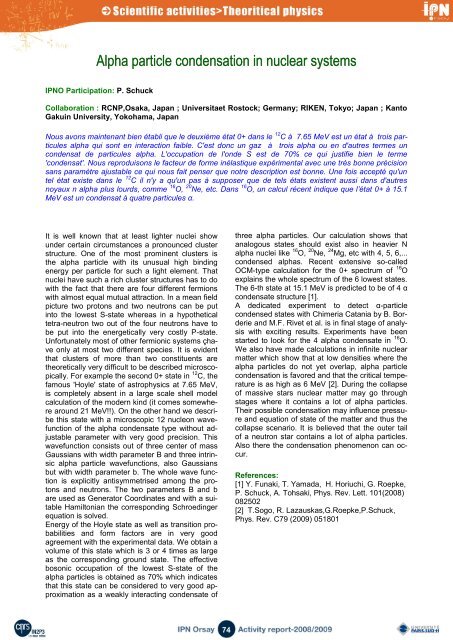exotic nuclei structure and reaction noyaux exotiques ... - IPN - IN2P3
exotic nuclei structure and reaction noyaux exotiques ... - IPN - IN2P3
exotic nuclei structure and reaction noyaux exotiques ... - IPN - IN2P3
Create successful ePaper yourself
Turn your PDF publications into a flip-book with our unique Google optimized e-Paper software.
Alpha particle condensation in nuclear systems<br />
<strong>IPN</strong>O Participation: P. Schuck<br />
Collaboration : RCNP,Osaka, Japan ; Universitaet Rostock; Germany; RIKEN, Tokyo; Japan ; Kanto<br />
Gakuin University, Yokohama, Japan<br />
Nous avons maintenant bien établi que le deuxième état 0+ dans le 12 C à 7.65 MeV est un état à trois particules<br />
alpha qui sont en interaction faible. C'est donc un gaz à trois alpha ou en d'autres termes un<br />
condensat de particules alpha. L'occupation de l'onde S est de 70% ce qui justifie bien le terme<br />
'condensat'. Nous reproduisons le facteur de forme inélastique expérimental avec une très bonne précision<br />
sans paramètre ajustable ce qui nous fait penser que notre description est bonne. Une fois accepté qu'un<br />
tel état existe dans le 12 C il n'y a qu'un pas à supposer que de tels états existent aussi dans d'autres<br />
<strong>noyaux</strong> n alpha plus lourds, comme 16 O, 20 Ne, etc. Dans 16 O, un calcul récent indique que l’état 0+ à 15.1<br />
MeV est un condensat à quatre particules α.<br />
It is well known that at least lighter <strong>nuclei</strong> show<br />
under certain circumstances a pronounced cluster<br />
<strong>structure</strong>. One of the most prominent clusters is<br />
the alpha particle with its unusual high binding<br />
energy per particle for such a light element. That<br />
<strong>nuclei</strong> have such a rich cluster <strong>structure</strong>s has to do<br />
with the fact that there are four different fermions<br />
with almost equal mutual attraction. In a mean field<br />
picture two protons <strong>and</strong> two neutrons can be put<br />
into the lowest S-state whereas in a hypothetical<br />
tetra-neutron two out of the four neutrons have to<br />
be put into the energetically very costly P-state.<br />
Unfortunately most of other fermionic systems çhave<br />
only at most two different species. It is evident<br />
that clusters of more than two constituents are<br />
theoretically very difficult to be described microscopically.<br />
For example the second 0+ state in 12 C, the<br />
famous 'Hoyle' state of astrophysics at 7.65 MeV,<br />
is completely absent in a large scale shell model<br />
calculation of the modern kind (it comes somewhere<br />
around 21 MeV!!). On the other h<strong>and</strong> we describe<br />
this state with a microscopic 12 nucleon wavefunction<br />
of the alpha condensate type without adjustable<br />
parameter with very good precision. This<br />
wavefunction consists out of three center of mass<br />
Gaussians with width parameter B <strong>and</strong> three intrinsic<br />
alpha particle wavefunctions, also Gaussians<br />
but with width parameter b. The whole wave function<br />
is explicitly antisymmetrised among the protons<br />
<strong>and</strong> neutrons. The two parameters B <strong>and</strong> b<br />
are used as Generator Coordinates <strong>and</strong> with a suitable<br />
Hamiltonian the corresponding Schroedinger<br />
equation is solved.<br />
Energy of the Hoyle state as well as transition probabilities<br />
<strong>and</strong> form factors are in very good<br />
agreement with the experimental data. We obtain a<br />
volume of this state which is 3 or 4 times as large<br />
as the corresponding ground state. The effective<br />
bosonic occupation of the lowest S-state of the<br />
alpha particles is obtained as 70% which indicates<br />
that this state can be considered to very good approximation<br />
as a weakly interacting condensate of<br />
three alpha particles. Our calculation shows that<br />
analogous states should exist also in heavier N<br />
alpha <strong>nuclei</strong> like 16 O, 20 Ne, 24 Mg, etc with 4, 5, 6,...<br />
condensed alphas. Recent extensive so-called<br />
OCM-type calculation for the 0+ spectrum of 16 O<br />
explains the whole spectrum of the 6 lowest states.<br />
The 6-th state at 15.1 MeV is predicted to be of 4 α<br />
condensate <strong>structure</strong> [1].<br />
A dedicated experiment to detect α-particle<br />
condensed states with Chimeria Catania by B. Borderie<br />
<strong>and</strong> M.F. Rivet et al. is in final stage of analysis<br />
with exciting results. Experiments have been<br />
started to look for the 4 alpha condensate in 16 O.<br />
We also have made calculations in infinite nuclear<br />
matter which show that at low densities where the<br />
alpha particles do not yet overlap, alpha particle<br />
condensation is favored <strong>and</strong> that the critical temperature<br />
is as high as 6 MeV [2]. During the collapse<br />
of massive stars nuclear matter may go through<br />
stages where it contains a lot of alpha particles.<br />
Their possible condensation may influence pressure<br />
<strong>and</strong> equation of state of the matter <strong>and</strong> thus the<br />
collapse scenario. It is believed that the outer tail<br />
of a neutron star contains a lot of alpha particles.<br />
Also there the condensation phenomenon can occur.<br />
References:<br />
[1] Y. Funaki, T. Yamada, H. Horiuchi, G. Roepke,<br />
P. Schuck, A. Tohsaki, Phys. Rev. Lett. 101(2008)<br />
082502<br />
[2] T.Sogo, R. Lazauskas,G.Roepke,P.Schuck,<br />
Phys. Rev. C79 (2009) 051801<br />
74

















